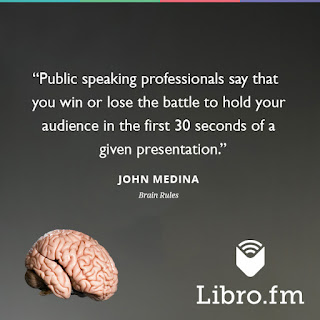We know that it takes you about 10 minutes to lose an audience if you’re just giving a normal talk. So at the nine-minute-and-59-second mark, you have to do something fairly radical. In fact, you should do it within 30 seconds of your first words, but certainly at nine minutes and 59 seconds. And here is where we can get into some brain science.
I think anybody who does speeches at all ought to really understand that the brain processes meaning before it processes detail. It wants the meaning of what it is that you’re talking about before it wants the detail of what it is you’re talking about. So then the question you can ask is, from a science point of view, what does meaning mean and what do you have to do at nine minutes and 59 seconds? It’s pretty simple. When a piece of information comes into the brain, your brain immediately interrogates it with six questions right off the bat. And you can see the Darwinian roots of the brain’s processing features really clearly here.
The first question it will ask is, will it eat me? You’re going to make an assessment of threat; that’s a survival mechanism. The second question is, can I eat it? Question number three is, can I have sex with it? And it’s actually not even sex per se. It’s, is there reproductive opportunity?
Question number four is, can it have sex with me? Questions number five and six to me are professionally the most interesting, because there’s no a priori for them. It just shows you something about how the brain learns: Have I seen it before? Or, have I never seen it before? The reason why is, the brain is an unbelievably gifted pattern matcher, and it’s looking for patterns that it’s seen.
So at nine minutes and 59 seconds, you’ve got to address one of those six questions or you’ll lose your audience. I call them hooks. I’ll give you an example. I teach second-year medical students and bioengineering graduate students. When I’m going to be talking about, say, hemispheric connections between the two [halves of the brain] — there’s an area of the braincalled the corpus callosum that actually communicates between the two hemispheres — I do not start out by saying, “The corpus callosum connects the two hemispheres, and here is the afferent and efferent neurocabling that connects these two hemispheres together.”
Nope. I’ll start it out with a story. Like, there was a woman who had a really strange behavior. If you were the psychiatrist, this woman comes into the room and she sits down and she starts talking to you, and immediately her left hand grabs her throat and she tries to strangle herself. No kidding. By the way, do I have your attention?
More links:
Attention Brain Rule
Brain Rules for Presenters on SlideShare (thanks to Garr Reynolds, author of Presentation Zen)
Get the Brain Rules (updated and expanded) eBook
Get the Brain Rules (updated and expanded) audiobook on Libro.fm









No comments:
Post a Comment